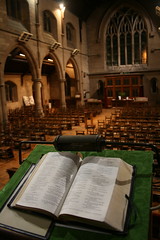Last November, a new parish history was launched for St Peter's Parish, on the Antrim Road in Belfast, written by Brian Barton (building on an earlier work by Richard Breene). I'm slowly getting to know the parish through having a friend in the recently appointed Rector, Adrian Dorrian. I've led a couple of services and preached there, as well as taken some photos.

However, whether I knew the parish or not, I have found Barton's book very interesting in several areas. Firstly, as a social history of the development of the town and City of Belfast. His opening chapter is purely social history with a dash of ecclesiastical history thrown in as well. The family history of the Donegalls (after whom quite a number of streets are named) is linked to the outward push of the growing industrial town, first to the west and south, then across the river Lagan to the east, and eventually along the northern shore of Belfast Lough. The surprising news that Belfast Castle is a mere baby, being completed in 1870, and the development of the new Antrim Road, and the movement for a new parish church to be erected in the locale.
Secondly, there are good portraits of the people involved - reminding us time and again that the church is not a building, but the people who are inside - from Rectors and churchwardens, to some of the founding committee, including Francis Bigger, a Protestant member of Sinn Fein, who served as secretary of the founding committee and of the first Select Vestry.
The Troubles are also covered, with the impact of mass population movements from north Belfast leading to a decline in the church's congregation, and the devastation of the bombing of the Landsdowne Court Hotel next door in 1987. Yet even with these set backs, the determination to continue to work for the kingdom shines through, as the buildings are restored and new halls built, and ministry continued through the centenary of the parish and church in 2000.
Another interesting section relates to the Chapel of the Resurrection, located off Inisfayle Park, which was originally part of the estate of Belfast Castle. The Chapel was a mortuary chapel for the Earl of Belfast (the original Black Man before the statue of Henry Cooke took up his spot at College Square, outside Inst), and was later transferred to St Peter's parish for Sunday afternoon services. Sadly, the building is not just a shell, having been targetted by vandalism and theft many times, but it still stands high on the hill, visible from the M5 and M2 travelling towards the city.
As well as the text, there are lots of full colour and black and white photos of the key features of the church building, and it will be a valuable and important contribution to both the social and religious history of that part of north Belfast. A good read, not just for those linked to the parish, but for any local historian with an interest in the development of Belfast, or in the social elite families like the Donegalls and Chichesters.
A History of St Peter's Parish, Antrim Road, Belfast is available from The Good Book Shop, Belfast.
No comments:
Post a Comment